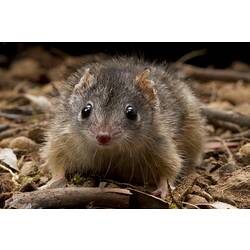Summary
This specimen was collected during William Blandowski's expedition to the junction of the Murray and Darling Rivers (December 1856 - December 1857). Its original tag '627' is still intact and the expedition register lists it only as 'Mouse'. It arrived at the museum in the second consignment from the expedition including only specimens collected 'in the neighbourhood of Gunbower' from 15-31 January 1857. This and another five specimens of the species were collected by local Aboriginal people during that extremely hot summer.
The Yellow-footed Antechinus was one of 34 mammal species recorded on the trip and this species was observed throughout the twelve month expedition; from Echuca, and Gunbower and Mondellimin (near Mildura), all the way up to the Murray-Darling rivers junction. Krefft observed it to "be so common near the camp on the Murray (Mondellimin), that I have often captured several specimens whenever a load of wood was brought in'. He kept specimens alive in camp to observe and draw, but found that they would "kill any number of mice, if put into the same box".
Kreftt made two illustrations of this species (Museum fur Naturkunde B VIII/240) on which he recorded the Koorie name of 'Vawrum' (probably the Yarree Yarree Aboriginal name from Mondellimin). In a later account published in 1866, Krefft recorded the name spelt slightly differently as 'Warum', the German-speaking Krefft would have written 'W' but pronounced it as 'V'. Back in Germany in 1860, Blandowski's artist Gustav Mutzel completed a painting of the whole animal (Museum fur Naturkunde B VIII/214) as Figure 2 in the plate of 'Dasyuridae' for the 'Mammals of Australia' series.
Specimen Details
-
Collection Names
-
Taxon Name
-
Preferred Common name
Yellow-footed Antechinus
-
Number Of Specimens
1
-
Sex
Female
-
Specimen Nature
Nature: Mount, Form: Dry
-
Expedition Name
-
Collected By
W Blandowski
-
Category
-
Scientific Group
-
Discipline
-
Collecting Areas
-
Type of Item
Taxonomy
-
Kingdom
-
Phylum
-
Subphylum
-
Class
-
Superorder
-
Order
-
Family
-
Subfamily
-
Genus
-
Species Name
flavipes

